| Home / Travelogues / |
Lebanon 2017-18 travelogue |
| Light
box | About | Contact |
Licensing
|  |

Overview
Costs
Food
Hotels
Money
Mobile phones
Internet
Weather
Health
VISA
Security
Recommended
Avoid
Getting around
Photos
Costs
Food
Hotels
Money
Mobile phones
Internet
Weather
Health
VISA
Security
Recommended
Avoid
Getting around
Photos

Beirut, Byblos, Baalbek, As Shouf, Beiteddine, Tyre, Anjar, Batroun, Tripoli, Qadisha valley, Cedars of God
 23.12: Munich -> Rome
23.12: Munich -> Rome24.12: Rome -> Beirut
25.12: Beirut
26.12: Beirut -> Byblos -> Beirut
27.12: Beirut -> Mzar Kfardebian -> Jounieh -> Beirut
28.12: Beirut -> Baalbek -> Beirut
29.12: Beirut -> Deir Al Qamar -> Beiteddine palace -> As Shouf cedar forest -> Kefraya winery -> Beirut
30.12: Beirut -> Sidon -> Tyre -> Beirut
31.12: Beirut -> Anjar -> Beirut
1.1: Beirut -> Tripoli -> Batroun
2.1: Batroun -> Qadisha valley/Cedars of god forest -> Batroun
3.1: Batroun
4.1: Batroun -> Beirut
5.1: Beirut
6.1: Beirut -> Rome -> Munich
Planning and overall impression
We chose Lebanon for this trip, because it was a destination we hadn't visited yet, suitable for a short two weeks trip (with just two weeks it doesn't make too much sense to travel to some place at the other end of the world). Then, it seemed that the situation in Lebanon had become more quiet, safe enough to go there (but see below the safety assessment I made).The other thing to plan was what to do and see, and where to stay in Lebanon. I used two guidebooks (the Bradt and the Lonely Planet ones; the Bradt guide is much more comprehensive) and put questions in the Thorntree travel forum.
Due to the geography of the country (relatively small with the capital Beirut at the centre) it seemed a good idea to use Beirut as a basis and do daytrips, and just stay in the north for a few days in order to minimise the driving time.
This turned out to be a mistake because the traffic in and around Beirut (especially between Beirut and Jounieh) is horrrible and you lose a lot of time getting out of and back to Beirut. Had I known about this, I would have limited my stay in Beirut to about two days and based myself south of Beirut, north of Beirut and in the Bekaa valley for a few days (I think Chtoura would have been the right place where to stay in the Bekaa valley).
Regarding the choice of places to visit, Lebanon is a country with a long history (7000 years of history or even more), very diverse geography with snow-covered mountains and beach areas less than two hours away from each other, and a rich cultural heritage due to the various ethnic and religious groups.
Unless you are planning to do a lot of swimming, the best time to visit probably is early spring, when there is still snow up in the mountains, but the coast is warm enough for swimming and it rains less.
Lebanon is not a low cost country for travelling. Hotels and restaurants can be quite pricey (especially restaurants in tourist hotspots). This made it a bit difficult for us to experience the local cuisine. It was too expensive, and the food in the reasonably priced restaurants was mediocre.
Costs
As explained above, Lebanon is not a low cost country for travelling. My guess is that's because it's a country frequently visited by wealthy gulf area people. In any case there is a lack of budget accomodations, with most hotels focussing on the middle to upper end. Also restaurants tend to be pricey. Local tours and taxis are not cheap either, so it's a good idea to rent a car to get around.Food
It may be the case that Lebanese food is good, but because most Lebanese restaurants are a bit expensive we often ate in lower cost alternatives, such as fast food places or food courts of shopping malls. For instance in Tyre we looked for a restaurant in the harbour area, but only found a few expensive restaurants. In some places (for instance Baabek) we ate in local Lebanese restaurants. The other thing is that since we spent the day travelling across Lebanon, often leaving late inthe morning after 10 or 11am, we often had no time to sit down in restaurant and spend 1-2 hours for a lunch. That's because days in early winter are short and end around 5pm. So sometimes we skipped lunch and just had a long dinner.The restaurants where we ate in Batroun and Bcharré were bad.
Then, in December-January many restaurants are closed in the tourist areas, probably because it is low season and there are few customers.
In any case, I have received a lot of complaints about the food in Lebanon. It may be the case that food in Lebanon is good, it's just that the food we found was not very good.
Accommodation
In Beirut we stayed in a decent, albeit a bit old mid-range place (the West House residence), centrally located in Beirut 's Hamra area. In Batroun we "splurged" on a resort hotel. This place was ok, except for the shower which was broken (either freezing cold or boiling hot. Beirut has several very expensive hotels, but not so many less expensive hotels. Outside of Beirut it is often difficult to find a hotel. For instance, there are not that many hotels in Tyre or Tripoli.Money / Exchange rate (December 2017 - January 2018)
1 Euro = 1800 LBP1 Euro ~ USD 1.20
For current exchange rates check the Universal Currency Converter.
Mobile phones and prepaid cards
At the Beirut airport we found only overpriced SIM cards (USD 40 for a SIM card of the operator Alfa with just 1.5GB of data and only 3 USD of airtime). Later in Beirut I bought a SIM card with 5GB of data for 43 USD, because I needed a mobile Internet connection.Then, the next day we found a shop selling Touch SIM cards with 3 USD of airtime (local calls for 23 cents of a USD) and 1GB of data for just 3.5 USD. That's basically the non-ripoff price of SIM cards in Lebanon.
Internet access
The first hotel offered free Internet in the room, but this was slow. The second hotel had again free Internet in the room, and this was fast. The third place (an apartment) charged USD 10/day for the Internet. Otherwise we relied on the mobile Internet connections of the smartphones.Weather
Winter is not the best time to visit Lebanon, because it rains a lot. Our first week was mostly sunny with daytime temperatures up to 20°C, while the second week wes more rainy, even if it didn't rain the whole day.Health / Vaccinations
No vaccinations needed for Lebanon.VISA / Entry requirements
VISA free entry (i.e. visa on arrival) for EU nationals and nationals of several other countries (including Malaysia).Security
This was one of the key aspects which we considered when planning the trip. On the one hand there was the situation with the civil war in Syria with the large influx of refugees into Lebanon. On the other hand the USA had just declared that they would move their Israeli embassy to Jerusalem, which generated widespread unrest in the region. I had booked the flights on September 24th, then kept monitoring the situation in Lebanon. In the worst case, I would have had to cancel the trip.Then, in December, as the situation in Lebanon seemed quiet and safe enough, we went ahead with the trip.
What we found was a very quiet and peaceful Lebanon, people caring about their everyday business etc. No demonstations or strange or unusual situations. Everything very relaxed and safe, even in hotspots such as Tripoli for instance. Baalbek in the Bekaa valley, supposedly where the Hisbollah are headquartered, just like an ordinary city.
To be fair, there was a strong presence of Lebanese military and security everywhere, especially on Christmas day in front of Christian churches (to prevent potential terrorist attacks). Military roadblocks at certain intervals on the major roads.
In fact despite the situation in nearby Syria, there has been relatively little spillover into Lebanon. Only a few terrorist attacks after the beginning of the Syrian civil war, then nothing more. It's also so, that shortly before we travelled to Lebanon the Lebanese army managed to regain control over the complete national territory, including the border areas.
The unsafest thing in Lebanon was actually the traffic on the streets, which was quite chaotic. When driving the car in Beirut and rhe region around it, it was necessary to be very careful and constantly monitor the situation. Away from Beirut there was much less traffic and the situation on the roads was much more relaxed.
Recommended things
- The snow covered mountains in the winter
- Byblos is a beautiful small coastal city
- The impressive Roman ruins in Baalbek and the Umayyad ruins in Anjar
- Tripoli is a hidden gem, with lots of history and local culture
- The wineries, in case you like to drink wine
- Trekking in the forests in the Lebanese mountains
Things to avoid
- Avoid driving along the coastal road between Beirut and Jounieh.
- More in general, avoid driving in Beirut and the area around Beirut.
- Don't use Beirut as a base to explore Lebanon (too much time lost in trafffic jams).
Getting around
In Beirut we initially used taxis to get around. After two days we rented a car and used that to travel around Lebanon. The traffic in Beirut is crazy, but once outside the Beirut region the traffic is quite relaxed. The roads are in a reasonable state, but there is only a short stretch of real motorway south of Beirut. The coastal road from Beirut to the north until Jounieh has often very bad traffic jams. In Beirut you have to drive very carefully.In principle it's possible to charter a taxi i Beirut to drive to places in Lebanon, but the prices are high.
Then, apparently there are long distance buses, but we didn't use them.
23.12: Munich -> Rome
Hotel Sirenetta, Lido di Ostia. 34 Euro (+5 Euro tax) for a nice room with a balcony and attached bathroom with shower. Simple furniture (cupboard, table+chair, small LCD TV). The room has a heater and an A/C unit which doubles as a heater. The hotel is along the seafront and has its own restaurant (pricey dishes - a simple dish of pasta starts at 11 Euro). Friendly, helpful staff. Free WLAN in the room. Surprisingly good buffet breakfast, especially considering the low price of the room (room rate includes the breakfast).
Weather: overcast in Munich, 6°C in the morning but no rain. Nice sunny day in Lido di Ostia, not cold. It only gets fresh after dark.
 We
leave home at 9:15am, then drive to the S-Bahn station, where we take
the next train to the airport. In Rosenheimer Platz and we take the
10:02am S8 train to the airport, arriving there around 10:40am. Then we check
the information board and see that the departure gate of the Alitalia flight
to Rome is D6, so we head to the D check-in area. Once there it turns
out that the check-in counters actually are in the A area (quite far
away from the D area). So we rush to the A area, arriving at the
check-in counter at 11am.
We
leave home at 9:15am, then drive to the S-Bahn station, where we take
the next train to the airport. In Rosenheimer Platz and we take the
10:02am S8 train to the airport, arriving there around 10:40am. Then we check
the information board and see that the departure gate of the Alitalia flight
to Rome is D6, so we head to the D check-in area. Once there it turns
out that the check-in counters actually are in the A area (quite far
away from the D area). So we rush to the A area, arriving at the
check-in counter at 11am. Long queue, only two counters open, working slowly. We finally check-in at 11:45am. Bad surprise, Alitalia can't give us our luggage in Rome, we'll only get it in Beirut. Not a good airline. But then we have to rush to the gate.

So we rush, rush, rush and arrive at the security check of the D area. Unbelievably long queue. No fast track available. Actually there is one, but the guy won't let us go through. More conversation at the info counter. They suggest to go to the C area where supposedly there are fewer people. So we get there, then jump the queue and finally are on the plane at 12:05pm. The plane is completely full. No space in the overhead compartments. Old A319 plane. Very narrow seat rows.

The flight takes off shortly before 1pm, with almost one hour of delay. Then the pilot manages to catch up a bit and we land in Rome Fiumicino airport shortly after 2pm, with just half an hour of delay.
Then the mess with the taxis starts. When we reach the arrivals area some people ask us if we want a taxi. Where are you going? Lido di Ostia. 50 Euro. Wow, a bit expensive for a 10km trip. We ask a number of people and get the same answer. These 50 Euro are the same price as the trip to Rome, which is 30km from here. Can you use the meter? No, fixed price. To the hell with the Roman taxi drivers who want to rip off tourists.
We lose time, walk out of the building, talk to more people. The price is lower now, "only" 40 Euro. Still a rip-off for 10km. I check Uber. 30 Euro for the trip, but the car has only space for four people. In the end, since it's already 2:45pm we take a taxi to the hotel for 40 Euro. I guess I won't be coming back to Rome in the near future.

So we drive to the hotel. The idea was to drop off the bags in the hotel, then quickly go to Rome. But I notice that the area is actually quite pleasant and the weather is good. Besides it's already 3:15pm when we arrive at the hotel. No point spending over 100 Euro for taxis to go to and come back from Rome. So we just spend the rest of the day in Lido di Ostia.
This is actually a quite nice place. Long sandy beach, although it's almost completely taken by beach clubs. Only very small sections of the beach are available to the non-paying public. We walk to the centre of Lido di Ostia, eat something in a rosticceria (kind of a place where they sell pieces of pizza - delicious). Then we walk to the seafront. Nice long promenade, great sunset views from the pier.
After sunset we walk into town and buy some groceries in a supermarket, then again eat some pizza. We are back in the hotel at 6:15pm.
24.12: Rome -> Beirut
West House residence, Beirut. The equivalent of 55 USD for a room with a kitchen area with a microwave oven and a water basin, but no plates or glasses. We are on the fourth floor and luckily there is an elevator. The hotel is old and run down. Slow WLAN Internet connection in the room. Broken light in the toilet. Unimpressive hotel, but at least it is centrally located in Hamra and is less expensive than other hotels in Beirut.
 Weather: beautiful sunny weather,
blue sky in Rome in the morning. Rain and 16°C in Beirut.
Weather: beautiful sunny weather,
blue sky in Rome in the morning. Rain and 16°C in Beirut.We get up at 7am with the sunrise, get read and shortly before 8am have breakfast. Around 9am we take a taxi to the airport. 35 Euro fixed price, no meter. At 9:08am we are at Fiumicino airport.
 There we
check in using the automated machines which print out our boarding
passes (the bags were already checked in yesterday until Beirut). It's
still early, but since there is no point waiting here, we proceed
through security and passport control and by 10am we reach the gates
area. The gate of the flight is still not assigned.
There we
check in using the automated machines which print out our boarding
passes (the bags were already checked in yesterday until Beirut). It's
still early, but since there is no point waiting here, we proceed
through security and passport control and by 10am we reach the gates
area. The gate of the flight is still not assigned.Modern and clean terminal. Lots of elegant and fashionable shops. Plenty of bars and restaurants as well, but everything is horribly expensive (7 Euro for a croisssant, to make an example).

So we sit down and wait for a while. At 10:40am we walk to the gate. Short queue, by 11:05am we are in the plane (an old A321 of Alitalia). The plane takes finally off at 11:52am, with 32 minutes of delay. It's almost completely full (only a few seats are empty).
We land in Beirut at 3:45pm local time. Then it takes a while to get out of the plane, because they have put us into the last row (36).
The Beirut airport looks old and run down. We walk to the arrivals area, fill out an arrivals card, then go through the passport control. No questions asked about Israel, but the guy checks all pages to see if there are stamps of Israel.
When we reach the luggage belts our bags are already here. I withdraw some cash from an ATM (7500 LBP fee for a 600000 LBP withdrawal - should have used another ATM), then we get to the arrivals area.
Bad surprise, they don't sell SIM cards at the airport.
 Then we look for a taxi. And the rip-off starts.
In
the end we are squeezed in an old Mercedes taxi which brings us to the
hotel for 60000 LBP (= 34 Euro, by meter). And the distance is only
10km. Same price as the Fiumicino airport taxi, but at least the
Fiumicino taxi was big enough, clean and modern.
Then we look for a taxi. And the rip-off starts.
In
the end we are squeezed in an old Mercedes taxi which brings us to the
hotel for 60000 LBP (= 34 Euro, by meter). And the distance is only
10km. Same price as the Fiumicino airport taxi, but at least the
Fiumicino taxi was big enough, clean and modern.By the way, it's raining and the streets are in not so great shape and quite dirty. The first impression of Lebanon is so-so.
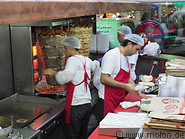 We
reach the hotel after 5pm. For some reason the rooms are not available
yet, so we just leave the bags here and walk into town. The area
consists of mostly modern and sort of fashionable shops.
We
reach the hotel after 5pm. For some reason the rooms are not available
yet, so we just leave the bags here and walk into town. The area
consists of mostly modern and sort of fashionable shops. We soon reach Hamra street, then walk a bit further. We run into a Lebanese restaurant (Barbar) where they serve Kebab and Lebanese food. This place is quite full of people and the food looks interesting, so we stop here for dinner.
I try the chicken shwarma, sort of a big dish with salad, French fries, chicken kebab and vegetables.
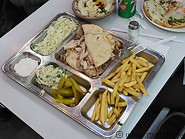 Shirley
tries an eggplant dish, my mom a vegetarian pizza. Overall
the
food is quite tasty.
Shirley
tries an eggplant dish, my mom a vegetarian pizza. Overall
the
food is quite tasty.Around 6:30pm we are done with the food.
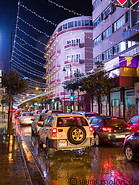 We
look for a shop selling SIM cards and find one. But the guy charges USD
40 for a SIM card of the operator Alfa with just 1.5GB of data and only
3 USD of airtime. Quite a rip-off. Then we walk to the next shop. Here
the guy says that the SIM card with no data costs USD 20 (and has USD 3
of airtime; calls within Lebanon are 23 cents of a USD, very
expensive). A 5GB data package costs USD 23. So I buy one SIM card with
5GB of data for 43 USD (= 64500 LBP).
We
look for a shop selling SIM cards and find one. But the guy charges USD
40 for a SIM card of the operator Alfa with just 1.5GB of data and only
3 USD of airtime. Quite a rip-off. Then we walk to the next shop. Here
the guy says that the SIM card with no data costs USD 20 (and has USD 3
of airtime; calls within Lebanon are 23 cents of a USD, very
expensive). A 5GB data package costs USD 23. So I buy one SIM card with
5GB of data for 43 USD (= 64500 LBP).Later in the hotel I read that the basic SIM card with no data should have cost 3 USD, not 20.
Then we walk back to the hotel. We can't find a supermarket selling food or a convenience store in the area near the hotel. There is a small bakery making sort of small pizzas (but who wants to eat old cold pizzas?), and some kind of break filled with spinach. Then there is a small microstore selling some (a bit overpriced) food adjacent to the hotel, and further away I find a larger store, but also this one with a limited offering.
I also check where the catholic church is because my mom wants to go there tomorrow (Xmas service).
25.12: Beirut
Hotel West House residence, Beirut. The shower is good, but the water is a bit salty.
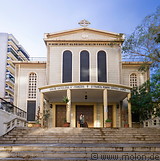 Weather: sunny, blue sky with some
clouds the whole day. Temperatures topping at 19°C.
Weather: sunny, blue sky with some
clouds the whole day. Temperatures topping at 19°C.I wake up before 8am, then get ready. Around 9:30am I leave the hotel with my mom, who wants to attend a catholic mass (today is Christmas).
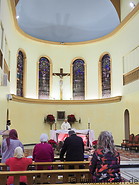 The St Francis church is Hamra street, a couple of hundred meter from
the hotel. We are there at 9:40pm.
The St Francis church is Hamra street, a couple of hundred meter from
the hotel. We are there at 9:40pm. Heavily armed soldiers in front of the church - probably in case somebody wants to do a terrorist attack. Wow, a queasy feeling when being inside the church.
We get in and check when the next service takes place. Aha, there is an Arabic language service which just started at 9:30am. At 10:30am there is a French language service, and at 11:30am an English language one. Since my mom understands none of these languages, we just join the Arabic language one.
Quite interesting. The church building is modern and there are very few people attending the mass. Some old people and some east Asian ladies (perhaps Filipino). Priest and other people speaking in Arabic, otherwise it's a standard catholic mass.
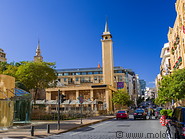
At 10:15am the mass is over. We walk out of the church. The priest is curious about where we come from. Chit chat in French and English, then we walk back to the hotel.
In the hotel we meet Albert, who apparently in the meantime woke up.
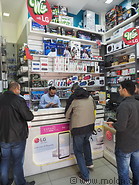 After 11am we walk out of the hotel and take a taxi to the Al Omari
mosque, which should be somewhere in the centre of the old town. The
taxi driver doesn't use the meter and asks for 12000 LBP.
After 11am we walk out of the hotel and take a taxi to the Al Omari
mosque, which should be somewhere in the centre of the old town. The
taxi driver doesn't use the meter and asks for 12000 LBP. We drop off the taxi opposite the Al Omari mosque at 11:38am. The first thing would be to get some cash and SIM cards, because so far only I have a SIM card.
We quickly find a shop selling Touch SIM cards. When we ask for the price, it's 3.5 USD for a SIM card with 3 USD of airtime (local calls cost 23 cents of a USD) and 1GB of data. What a surprise. Yesterday I was quoted 40 USD for a SIM card with 3 USD of airtime and 1.5 GB of data and then spent 43 USD for a SIM card with 5GB of data and now it turns out that the real price of SIM cards with 1GB of data actually is 3.5 USD.
Albert tells me that at the airport, when he arrived, people asked him 57 USD for a SIM card. That's why he didn't buy it.
So Lebanon is a country where people like to rip off tourists. Mobile phone operators make all the hard work of building and managing a mobile phone network, but then there are some cheaters who end up making all the money.
This time a passport is needed to get the SIM card (yesterday when I bought the expensive SIM card the guy didn't ask for it). I'm the only one with a passport
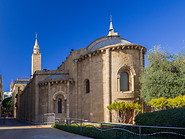 (luckily I insisted in having my passport this
morning at the hotel - hotel staff said it is not safe to carry a
passport with us, that we should leave it in the hotel). They will only
sell me two SIM cards, so I get one for Albert and one for Shirley.
(luckily I insisted in having my passport this
morning at the hotel - hotel staff said it is not safe to carry a
passport with us, that we should leave it in the hotel). They will only
sell me two SIM cards, so I get one for Albert and one for Shirley.When we are done with the SIM card, we cross the street and walk towards the mosque.
 There is a secured perimeter around the area of the mosque. Metal
barriers guarded by soldiers armed with machine guns. We discover
later that we are entering a special area with a number of special
buildings (mosques, churches, palaces) where a terrorist could think of making bombing.
There is a secured perimeter around the area of the mosque. Metal
barriers guarded by soldiers armed with machine guns. We discover
later that we are entering a special area with a number of special
buildings (mosques, churches, palaces) where a terrorist could think of making bombing.We soon reach the Nijmeh square (place de l'Étoile), a very scenic square with a clock tower in the middle. Turns out that the Lebanese parliament is on it, and the Al-Omari mosque and the St George Greek orthodox church are not far from it.

From the Nijmeh square we continue walking towards the other mosque we spotted (the pretty Al-Amin mosque), passing by the ruins of the Roman forum of Beirut. The entire area is absolutely gorgeous and photogenic.
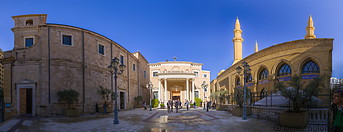
When we reach the Gouraud street we turn left and walk towards the Al-Amin mosque. We immediately reach another heavily guarded place. Lots of soldiers with machine guns, armoured cars, concrete barriers. Not sure what exactly is so critical. Looking at the pictures later I realise that in this spot there are two churches (a Christian Maronite, a Christian orthodox one) and a mosque.
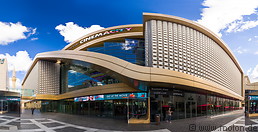 We wade through the people, the machine gun soldiers, spend more time
exploring the area then slowly walk back to the Nijmeh square. By now
it's 1pm, people are getting hungry and start complaining.
There are some restaurants in the area, but they are heavily
overpriced (15 Euro for some simple spaghetti).
We wade through the people, the machine gun soldiers, spend more time
exploring the area then slowly walk back to the Nijmeh square. By now
it's 1pm, people are getting hungry and start complaining.
There are some restaurants in the area, but they are heavily
overpriced (15 Euro for some simple spaghetti).We continue walking around and almost by concidence we run into the Beirut souks area. In the Cinemacity building we find a food court where we have some lunch.
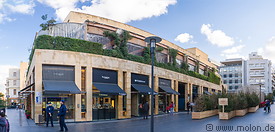 The
food is good, but not exactly inexpensive.
The
food is good, but not exactly inexpensive.This Cinemacity building is modern and flashy. Nice and elegant inside.
After the food, at 1:45pm we get out again and have a look at the area.
The Beirut Souks are a modern open air shopping mall with gorgeously elegant shops in a narrow alley pattern, mimicking the layout of an ancient souk. All shops sell luxury and high end goods or apparel / fashion stuff.

Shortly before 3pm we take a taxi to the Pigeon rocks. This time the guy asks for 20000 LBP.
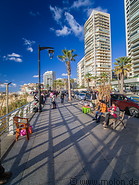
Getting there takes about 10 minutes and on the way the guy tries to sell us trips to the interesting places in Lebanon.
It's 3:08pm when we are at the viewpoint of the rocks. Very scenic rocks emerging from the water. Right now the sun is in an unfavourable position, almost facing us. Walking down the promenade I notice that there is a path leading down to the sea water (the viewpoint is about 30m above sea level).
After the photos we slowly walk along the seafront towards the lighthouse. On the way we stop for an icecream (this time not overpriced
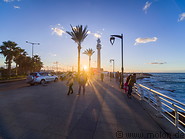 - only 1 USD per scoop). The taste is not bad.
- only 1 USD per scoop). The taste is not bad.We continue walking until almost sunset. Then, after 4:30pm, we look for a taxi. This time we find no 7-seater car and end up taking two cars, for 10 USD each (15000 LBP).
We go to the Beirut City Centre mall,
 a nice and elegant mall which opened in
2013, arriving there at 5:03pm. Now the second driver starts making
trouble and asks for 15 USD instead of the 10 USD he initially asked
for. The first driver instead accepts the 10 USD without complaining.
And I hear that the bad driver (Albert and the kids were with him) was
smoking while driving and hearing very loud music.
a nice and elegant mall which opened in
2013, arriving there at 5:03pm. Now the second driver starts making
trouble and asks for 15 USD instead of the 10 USD he initially asked
for. The first driver instead accepts the 10 USD without complaining.
And I hear that the bad driver (Albert and the kids were with him) was
smoking while driving and hearing very loud music.We get into the mall. This is actually less impressive than I had originally thought. It's one long block with three floors, with nice shops and one central ellyptical area
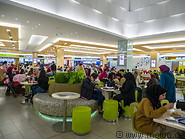 , beautifully decorated,
but there is no architecturally stunning feature. There is a food court on the second floor and a
Carrefour hypermarket at one end. Somehow the size is not so big,
probably because there was not so much space when the mall was built.
, beautifully decorated,
but there is no architecturally stunning feature. There is a food court on the second floor and a
Carrefour hypermarket at one end. Somehow the size is not so big,
probably because there was not so much space when the mall was built.After some strolling, we sit down in the food court and eat something. Food in this food court is quite pricey and the quality and choice is limited (lots of fast food outlets).
After 7pm we take a taxi (15000 LBP) back to the hotel. We are lucky to find one 7-seater car willing to do the trip for 15000 LBP. Initially some drivers were suggesting that we take two cars, for 15000 LBP each.
26.12: Beirut -> Byblos -> Beirut
Hotel West House residence, Beirut.
Weather: sunny. spotless blue sky the whole day. Temperatures probably close to 20°C.
In the morning we take a taxi (30000 LBP) to the airport, to go and fetch the rental car. We arrive at the CityCar counter at 11:30am and luckily there is only one customer before us.
 The paperwork takes about 20
minutes and shortly before 12pm we have the car, a Toyota Avanza with 7
seats (automatic gear, 21900 km, gasoline, tank is full).
The paperwork takes about 20
minutes and shortly before 12pm we have the car, a Toyota Avanza with 7
seats (automatic gear, 21900 km, gasoline, tank is full). The car is not terribly big, but because it's tall (minivan format), it's big enough for us.
I key in the souq in Byblos as the destination in the Google Maps app and shortly after 12pm we start driving. Initially the traffic is quite smooth, but then when we have to drive through Beirut, we end up in a number of traffic jams, luckily all quite small.
To drive to Byblos you have to take the coastal road, where apparently today everybody is driving. Traffic jams and slow moving traffic until after Jounieh. Only the last 10-15km are with fluid traffic.
There is just a coastal road, but no motorway, which is amazing given that this is a country where everything is so expensive. Seems that no money is left for motorways.
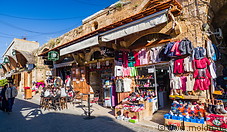
By the way, it seems that there are very few motorbikes on the roads. Looks like everybody is driving a car.
We reach Byblos at 1:28pm and park the car in a place along the street where parking costs 1000 LBP/hour (payment only possible with coins).
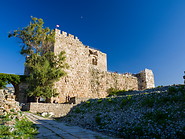 Then we walk towards the old town. It becomes quickly obvious that Byblos is a major tourist hotspot. The
kind of cute, interesting small harbour city with a lot of past which
everybody wants to see. We walk through the souqs, where
there are countless souvenir shops.
Then we walk towards the old town. It becomes quickly obvious that Byblos is a major tourist hotspot. The
kind of cute, interesting small harbour city with a lot of past which
everybody wants to see. We walk through the souqs, where
there are countless souvenir shops. Shortly before 2pm we reach the castle. Because it's quite late, we look for a restaurant. Surprise, surprise, prices here are even higher than in Beirut. Actually it's likely that prices here are high because it's the old town and perhaps a bit lower outside the old town.
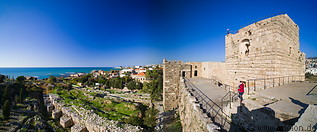
Albert and I are not terribly hungry, but because there are just 2 1/2 hours of sun left, we would like to visit the castle. So we split. The ladies will look for a restaurant, while Albert and I will explore the archaeological area.
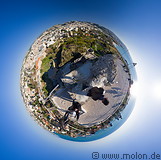 The ticket to the crusader castle costs
8000 LBP. The castle (the ruins of it) is quite photogenic. From the
top of the tower you have a great view of Byblos and the surroundings.
It's a rocky coast, but there is also a long sandy beach. The castle is
within a compound where there are a number of ruins. Inside the castle
there is a small museum with some exhibits.
The ticket to the crusader castle costs
8000 LBP. The castle (the ruins of it) is quite photogenic. From the
top of the tower you have a great view of Byblos and the surroundings.
It's a rocky coast, but there is also a long sandy beach. The castle is
within a compound where there are a number of ruins. Inside the castle
there is a small museum with some exhibits.We are in the archaeolgical area until almost 3pm, then walk to the ladies who by now are in a restaurant having some food. The restaurant (Kaddoum center) is kind of a stylish/modern type of place immediately outside the old town. The food is quite good, actually really not bad. We only have some small things (basically sandwiches) because we are planning to have a better meal after sunset.
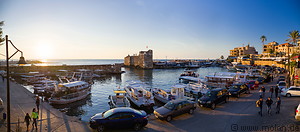
It'a almost 4pm when we are done with the food, We then walk towards the harbour where we stay until sunset at 4:35pm. Very nice old hustoric harbour, with a fortified tower guarding the harbour. Nice views of the sea and the sunset. Lots of people around.
After sunset we spend some time shopping around in the souq.
 As it gets dark, Byblos starts looking
really very nice, with the lights illuminating the old stones and
structures. Outside the old town there is a huge illuminated metal
Xmas tree and countless Xmas lights on the bushes in the small park.
As it gets dark, Byblos starts looking
really very nice, with the lights illuminating the old stones and
structures. Outside the old town there is a huge illuminated metal
Xmas tree and countless Xmas lights on the bushes in the small park. Seems that they take Xmas very seriously in Lebanon, because everywhere there are Xmas decorations.
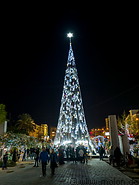
Around 5:45pm we start driving back. I've keyed in the Beirut Citymall as the next destination, because I'm thinking of having a look there and having dinner there. Because there is some traffic jam along the way, Google Maps estimates that we will arrive at 7:06pm.
What happens then is a traffic jam mess. At one point Google Maps guides us out of the main coastal road, so that we can save some time by bypassing the traffic jam. In reality we'll end up stuck in a horrible traffic jam, which will make us lose about one hour. Basically we get stuck in a road which runs parallel to the main coastal road, where there are two lanes, but three rows of cars. Very slow speed, something like one hour to do 1km.
 And I must say that the Lebanese
drivers are very creative for what concerns finding new routes or new
lanes. Some drivers are even quite aggressive and daring. Some cars
cross the wall barrier to get on the faster coastal road, even if that
means damaging their cars.
And I must say that the Lebanese
drivers are very creative for what concerns finding new routes or new
lanes. Some drivers are even quite aggressive and daring. Some cars
cross the wall barrier to get on the faster coastal road, even if that
means damaging their cars.In the end we change our plans and drive back to the hotel, because there is no time to go to the Citymall. We arrive finally at 8:45pm, which means that to do the 40km between Byblos and the hotel we have needed three hours.
We park the car in an empty parking along the street. Parking is free until the next morning at 9am (then it costs money until 4pm).
After 9pm we walk to the Barbar restaurant where we had had dinner the other day. Late dinner at 10pm, then we walk back to the hotel. The plan for tomorrow is to visit Baalbek.
27.12: Beirut -> Mzar Kfardebian -> Jounieh -> Beirut
Hotel West House residence, Beirut.
Weather: sunny, blue sky with a thin clouds layer. Mild temperature, probably topping out at 19°C.

In the morning we manage to leave the hotel at 10am. The plan is to drive to Baalbek, making a stop at the Mzar Kfardebian ski resort. Initially there is some light traffic jam on the coastal road, but after a while it dissolves.
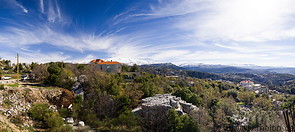
Then, shortly before Jounieh the road turns to the interior and we start climbing up the mountains. It's an easy road, because the slopes are not so steep and the curves are quite wide (no narrow curves). Which means that the people in the car get no travel sickness.
The scenery is beautiful and the air
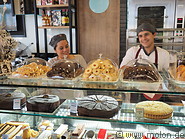 here is much, much
more clean than in Beirut. Great views on this sunny day.
here is much, much
more clean than in Beirut. Great views on this sunny day.Along the way we stop at a Wooden Bakery pastry shop for some snacks. We'll end up buying half a kg of pastries and on the way back will make another stop to buy even more pastries, because they are so delicious.
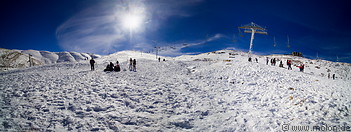
With some photo stops along the way, we reach the Mzar Kfardebian ski resort shortly after 12pm. The sun is shining, but a strong cold wind is blowing. There is snow on the slopes, but not enough for skiing so that all lifts are closed. Lots of people on the slopes playing in the snow. The altitude is 1889m, not bad.
Since it's really cold (well, actually it's the wind) the ladies all rush to a cafe where it's warm. With Albert I walk a bit on the snow, then even Albert retreats to the cafe. And after some photos I also walk to the cafe, where I join the others for a cup of tea.
 Shortly before
1pm we continue driving. The idea is to get to Baalbek and have a look
at the temple ruins. But after a few minutes we are stopped
at a
roadblock. A soldier won't let us pass through, because our car is not
a 4WD. Apparently the street later on is covered by snow and
our
car doesn't have suitable tires.
Shortly before
1pm we continue driving. The idea is to get to Baalbek and have a look
at the temple ruins. But after a few minutes we are stopped
at a
roadblock. A soldier won't let us pass through, because our car is not
a 4WD. Apparently the street later on is covered by snow and
our
car doesn't have suitable tires.So we have to make a U-turn and replan the trip. On the way back there are the Jeita grottoes, which supposedly are interesting. Driving back along the same road and after some time turning left, we reach the grottoes at 1:45pm. Google Maps either
 has some outdated maps or contains some bugs, because at one point it
sends us to the wrong place.
has some outdated maps or contains some bugs, because at one point it
sends us to the wrong place.Anyway, when we arrive the first thing is to pay the parking fee (2200 LBP). Then we drive the car into the parking.
There is a train or a cable car which brings people to the caves. It turns out that photography inside the caves is not allowed, so I decide to skip the caves. Since I'm not going, the ladies also do not want to go. Only Albert wants to go. So we split, and at 3:45pm when Albert is back from the caves we rejoin.
 Then, since the sun is going to set soon anyway, we drive to the coast
at Jounieh. The idea is to have a look.
Then, since the sun is going to set soon anyway, we drive to the coast
at Jounieh. The idea is to have a look. Arriving at 4:15pm we are lucky to find a parking along the road. Jounieh is a city or suburb of Beirut, located along the coast. There are a few old looking buildings in the centre, but otherwise all buildings are quite modern. The place is not terribly impressive. There is no nice promenade along the coast with nice views, cafes and shops. The entire waterfront is off-limits, fenced in private property.

We stay there until a bit after 5pm, then drive to the next place. This is a restaurant in the Zalqa area of Beirut, rated highly in the zomato.com restaurant directory. The name is "Manghal".
So we drive to this place. Initially we drive along the coastal highway, then after some time Google Maps sends us off the coastal highway to avoid a traffic jam and save some time. Somebody should beat the developers of Google Maps with a stick, because this navigation advice of Google Maps backfires horribly.
Initially everything is fine, but when we want to get back into the coastal highway, the entry is blocked by the police. So starts an odyssey which delays us by half an hour. Stupid developers of Google Maps. The same thing already happened yesterday. We should just have stayed in the coastal highway and ignored the directions of Google Maps.

Anyway, at 6:25pm we finally are next to the place where the Manghal restaurant is supposed to be. At first we cannot find the restaurant, then we ask some people. It's turns out that this Manghal restaurant is a small take away eatery on the third floor of a building. Quite unimpressive food, and quite a difference from the look on the zomato.com wesbite. You really can't trust websites sometimes.
So we look for another restaurant and quickly find one (the Diwan Al Hachem). We have dinner there (food is unimpressive, very greasy and not fresh). Shirley is getting disappointed. Already three days in Lebanon and the food has been unimpressive. Where the food is perhaps good, it's extremely expensive, where it's not so expensive but not cheap either, it's not good.
So we drive back to the hotel and again are stuck in a traffic jam. Too many traffic jams in this country, really tiring driving in Beirut. Later in the hotel I'm told that it's the coastal area between Beirut and Jounieh which is so stuck at this time of the year.
28.12: Beirut -> Baalbek -> Beirut
Hotel West House residence, Beirut. Today the hotel allows us to park the car in front of the hotel.
 Weather: sunny but overcast with
thin clouds layer, no rain. Fresh in Baalbek at altitude.
Weather: sunny but overcast with
thin clouds layer, no rain. Fresh in Baalbek at altitude. We
leave the hotel after 10am, but only start driving towards
Baalbek around 10:30am. Along the way we stop to refuel the car (seems
that the tank is small). Heavy traffic in Beirut, then outside of the
urban area then traffic becomes very smooth. Sort of a highway climbing
up the coastal mountain range, but very few narrow curves.
We
leave the hotel after 10am, but only start driving towards
Baalbek around 10:30am. Along the way we stop to refuel the car (seems
that the tank is small). Heavy traffic in Beirut, then outside of the
urban area then traffic becomes very smooth. Sort of a highway climbing
up the coastal mountain range, but very few narrow curves.Mostly fliuid traffic, speeds around 80km/h, occasionally the limit is 100km/h or 60km/h in the urban areas. The road is not bad, but not very smooth either. Every now and then checkpoints of the military, where soldiers probably are looking for terrorists or foreign fighters.
We are driving on the road passing by Chtoura, the socalled "Damascus highway".
 At 11:45am we pass the highest point at 1200m of altitude and
stop for a few minutes to take some pictures of the Bekaa valley and
the mountains.
At 11:45am we pass the highest point at 1200m of altitude and
stop for a few minutes to take some pictures of the Bekaa valley and
the mountains.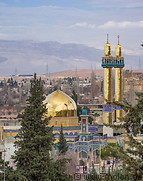
Then we continue driving. The road now is quite straight with few curves, which means that you can drive at the speed limit of 80km/h.
We reach Baalbek shortly before 1pm. Initially we stop in a place to take some panoramic views of the Roman temples. Then we continue driving to the actual temples and after some searching, park the car in town (free parking). From there we walk to the Roman ruins.
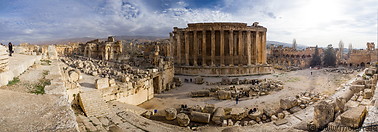 Our visit of the Roman ruins starts at 1:45pm.
The compound is fenced in and very big.
Our visit of the Roman ruins starts at 1:45pm.
The compound is fenced in and very big. 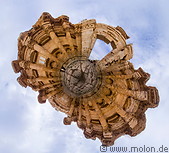 The entry ticket costs 15000
LBP. Inside the compound there are the ruins of palaces and temples of
the Roman era, dating back to the first centuries AD. The huge size of
the buildings combined with the big area of the compound makes this
place special. There are fragments of buildings and columns still
showing the ancient patterns.
The entry ticket costs 15000
LBP. Inside the compound there are the ruins of palaces and temples of
the Roman era, dating back to the first centuries AD. The huge size of
the buildings combined with the big area of the compound makes this
place special. There are fragments of buildings and columns still
showing the ancient patterns.We spend one hour and a half in the compound and at 3:15pm get out and start looking for a restaurant. Google Maps shows three places,
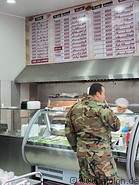 of which the first one seems
unimpressive, but the second one, the Ajami restaurant, looks ok. So
we choose this restaurant.
of which the first one seems
unimpressive, but the second one, the Ajami restaurant, looks ok. So
we choose this restaurant.This is a place where you can order take away food or sit down and have the food at a table. And again, also here there are rotating kebab rolls (like in all Lebanese restaurants where we have been so far).
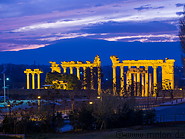 The food is reasonably priced,
portions are big and the taste is good.
The food is reasonably priced,
portions are big and the taste is good.Shortly before 4:30pm we are done with the meal and walk back to the car. We now drive to the Ksara winery, where we would like to taste some wine. It's on the way back, so there is no detour.
We arrive at 5:48pm, but that apparently is already too late. So we just continue driving toward Beirut. On the way we stop at a Wooden Bakery pastry shop and buy some cookies and groceries in the attached supermarket.
At 7:30pm we are in the centre of Beirut. This time driving has been quite smooth with no traffic jam until the Beirut urban core. Then we do another photo stop in the centre, and at 8:10pm are back in the hotel.
29.12: Beirut -> Deir Al Qamar -> Beiteddine palace -> As Shouf cedar forest -> Kefraya winery -> Beirut
Hotel West House residence, Beirut.
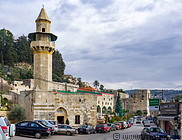 Weather: mostly overcast, with some
blue patches and some sun. Some light rain in the mountains.
Weather: mostly overcast, with some
blue patches and some sun. Some light rain in the mountains.We leave the hotel shortly after 10pm and drive towards Deir Al Qamar. Initially there is some traffic jam in Hamra, but immediately once we reach the highway to the airport, the road is free and we are able to drive at the maximum allowed speed. At some point we leave the coastal highway and drive inland, climbing the local mountain range.

At 11:15am we arrive at Deir El Qamar. This is a small town in the mountains at an altitude of 800m. When we arrive, the sun comes out. The historic core is not very big but quite cute. It's basically centered around the Dany Chamoun square. Here there are a mosque, a couple of palaces and a church complex.
It's a cute small town, but there isn't too much to see, so at 12pm we walk back to the car.
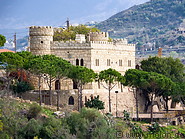 The owner of a vegetable shop complains that we parked the car in
front of his shop. But there is a big 'P' sign right next to the car.
Yes, but you are ony allowed to park here for five minutes. The problem
is that the text next to the P sign is completely in Arabic -
impossible to read.
The owner of a vegetable shop complains that we parked the car in
front of his shop. But there is a big 'P' sign right next to the car.
Yes, but you are ony allowed to park here for five minutes. The problem
is that the text next to the P sign is completely in Arabic -
impossible to read.We drive to the next place, the Moussa castle. This is only a few minutes away along the main street. A picturesqque little castle, in a nice position. The only problem is that this castle was built only 30 years ago,
 i.e. is not exactly a historic
place. Seems that inside there is a museum.
i.e. is not exactly a historic
place. Seems that inside there is a museum. We only spend a couple of minutes here, then drive to the next place, the Beiteddine palace.
It takes only a few minutes to get there. The Beiteddine palace (ticket: 10000 LBP) is an 18th century palace built by a local emir. There is a big and free car parking right outside the palace.
 Inside the palace
has a large courtyard surrounded on three sides by palace wings, which
are in turn surrounded by a park. The palace extends over three levels.
Inside the palace
has a large courtyard surrounded on three sides by palace wings, which
are in turn surrounded by a park. The palace extends over three levels. 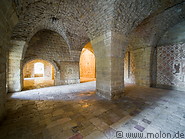 The lowest level consists of cellar like rooms with arched roofs, which
host some Byzantine era mosaics. On the ground and first level there
are more or less nicely decorated palace rooms.
The lowest level consists of cellar like rooms with arched roofs, which
host some Byzantine era mosaics. On the ground and first level there
are more or less nicely decorated palace rooms.We spend almost one hour in this palace and could have actually stayed longer, because there is plenty to see. But we get into the car and drive to the next place, the As Shouf Cedar reserve.
 This is located in the
mountains above the Beiteddine palace. Getting there takes about 40
minutes by car.
This is located in the
mountains above the Beiteddine palace. Getting there takes about 40
minutes by car.  The final part of the road is a narrow (but still
paved) mountain road which climbs until 1450m above sea level. At the
very top there is a small parking for cars. It's a bit after
2pm
when we arrive.
The final part of the road is a narrow (but still
paved) mountain road which climbs until 1450m above sea level. At the
very top there is a small parking for cars. It's a bit after
2pm
when we arrive. When we arrive and get ready for a walk in the Cedar forest, a car arrives. It's the car of the caretaker of the nature reserve. Seems we drove through without paying the ticket (7000 LBP per adult; children don't pay). The guy also tells us that that we must be back by 3:30pm, because after that the reserve closes.
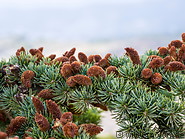
This As Shouf Cedar reserve is one of the few remaining patches of cedar forest in Lebenon. Once Lebanon was completely covered by cedar forest, but over the centuries the cedars were almost all cut because of their wood.
There is a trail, actually a number of trails in this patch of cedar forest. A short one (20 minutes) and an intermediate one (2 hours). We start walking along one trail. It's a relatively narrow forest trail, which in some parts is steep and / or humid. The forest is not that dense.
Around 3:15pm we drive back. At the security gate I get out and pay for the tickets, then start driving to the next destination, the Chateau Kefraya winery in Kefraya. To get there you have to drive across the mountains. Initially we drive down the mountain road towards Beiteddine, then at one point turn left and start driving on another mountain road.

The problem is that at one point this mountain road is blocked, because it goes through another cedar tree forest reserve which by now is closed. So we have to backtrack and take yet another mountain road.
We drive and drive up the mountain, until at 4:15pm we reach the highest point at over 1800m above sea level. Outside it's quite cold and there is some snow. From there the road goes down and by 4:50pm we reach the winery.
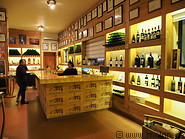 The
Chateau Kefraya winery is in the Bekaa valley just outside the Kefraya
village. There are guided tours through the winery, which at this time
are not available any more, and a restaurant/shop where you can dine,
buy wine ot taste wines. We taste a white wine and a rosé wine. The
white wine is actually quite good (much better than the wine we tasted
in the wine cellar in Georgia), and just tasting the wine costs
nothing.
The
Chateau Kefraya winery is in the Bekaa valley just outside the Kefraya
village. There are guided tours through the winery, which at this time
are not available any more, and a restaurant/shop where you can dine,
buy wine ot taste wines. We taste a white wine and a rosé wine. The
white wine is actually quite good (much better than the wine we tasted
in the wine cellar in Georgia), and just tasting the wine costs
nothing. 
Surprisingly the wine is also not expensive. One 0.75l bottle of the white one costs 16000 LBP. The restaurant of the winery instead is quite pricey.
At 5:05pm we leave the winery and look for a restaurant. Since two of the restaurants which Google Maps has indicated either are closed or do not exist (seems Google Maps is a bit outdated in the Bekaa valley), we drive to Chtoura and have dinner there.
The reasoning is that Chtoura is a larger city with plenty of restaurants so it should be easy to find a restaurant there. We have a nice dinner after 6pm. At 7:40pm we start driving back to Beirut and reach the hotel before 9pm.
30.12: Beirut -> Sidon -> Tyre -> Beirut
Hotel West House residence, Beirut.
Weather: a mix of overcast and sunny, mostly the sky covered with clouds, every now and then some blue sky. Some very light rain for a few minutes in the early afternoon in Tyre.
In the morning we say good-bye to Albert who is leaving the Lebanon this afternoon.
We leave Beirut around 10:40am and drive towards Sidon. The idea would be to stop for a moment to take a photo of the sea castle and then continue to the main destination of the day, Tyre. The weather is variable and I'm hoping to find sunny weather in both Sidon and Tyre.
Today surprisingly there is much less traffic in the streets of Beirut.
 We
reach the coastal highway quite quickly and suddenly are able to drive
at the max. allowed speed of 80km/h. Later, out of Beirut, the top
speed limit will rise to 100 km/h.
We
reach the coastal highway quite quickly and suddenly are able to drive
at the max. allowed speed of 80km/h. Later, out of Beirut, the top
speed limit will rise to 100 km/h.Shortly after 11:30am we are in Sidon at the sea castle. This looks far less impressive than in the pictures, also because right next to it is the harbour with the big, commercial ships. Ugly cranes and container ships. Sidon itself doesn't look that great either. A messy costal city, probably that's the reason the travel guides don't recommend it.
 At 11:40am we continue
driving towards Tyre. As soon as we reach the coastal highway (by now
it's three lanes per direction), we can speed up to 100km/h. Very
smooth and fast drive to Tyre. At one point there is a military
checkpoint in the middle of the motorway. Not terribly well marked -
might cause accidents if people don't brake fast enough.
At 11:40am we continue
driving towards Tyre. As soon as we reach the coastal highway (by now
it's three lanes per direction), we can speed up to 100km/h. Very
smooth and fast drive to Tyre. At one point there is a military
checkpoint in the middle of the motorway. Not terribly well marked -
might cause accidents if people don't brake fast enough. The highway continues, but not until Tyre. 10-15km from Tyre the coastal highway ends and you need to get onto another coastal road to actually reach Tyre. At 12:20pm we spot a free parking slot in Tyre and park the car.
Some military roadblocks along the way, UN military cars on the roads. Later in the afternoon a convoy of military cars passes by.
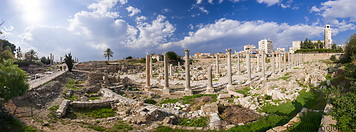 Two armored vehicles with soldiers on top manning a heavy machine gun,
one final armored vehicle with the machine gun pointing to the back.
Everything is peaceful but wow, what a troubled country.
Two armored vehicles with soldiers on top manning a heavy machine gun,
one final armored vehicle with the machine gun pointing to the back.
Everything is peaceful but wow, what a troubled country.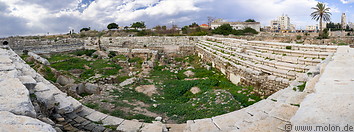 We
slowly walk to the first archaeological area, arriving there at
12:30pm. This is a largish area with many ruins, spread over an area of
500m x 200m on the peninsula. The entrance costs 6000 LBP (children do
not pay). There are a colonnade and the ruins of Roman era baths. Lots
of broken stones, but overall the ruins are not too impressive,
i.e.there are no great structures left.
We
slowly walk to the first archaeological area, arriving there at
12:30pm. This is a largish area with many ruins, spread over an area of
500m x 200m on the peninsula. The entrance costs 6000 LBP (children do
not pay). There are a colonnade and the ruins of Roman era baths. Lots
of broken stones, but overall the ruins are not too impressive,
i.e.there are no great structures left.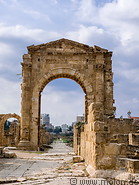 We are here until
1:05pm, then walk back to the car and drive to the other archaeological
site, the one around the hyppodrome. Initially Google Maps guides us to
the wrong place (and that is not the first time here in Lebanon - this
happens practically every day,
We are here until
1:05pm, then walk back to the car and drive to the other archaeological
site, the one around the hyppodrome. Initially Google Maps guides us to
the wrong place (and that is not the first time here in Lebanon - this
happens practically every day,  probably because the maps of Google Maps
are outdated). Then we ignore the directions of Google Maps and just
drive to another place where probably the entrance to the site is, and
indeed the entrance is there. We arrive a 1:40pm.
probably because the maps of Google Maps
are outdated). Then we ignore the directions of Google Maps and just
drive to another place where probably the entrance to the site is, and
indeed the entrance is there. We arrive a 1:40pm.This site (entrance: 6000 LBP) is larger than the first one and more interesting, because the contained structures are more varied. The highlight is the area around the hyppodrome, then there are colonnades and other buildings.
 We leave the archaeological site at 2:35pm and walk
back to the car. There I key in the harbour area, thinking that it
should be possible to find a restaurant there.
We leave the archaeological site at 2:35pm and walk
back to the car. There I key in the harbour area, thinking that it
should be possible to find a restaurant there. 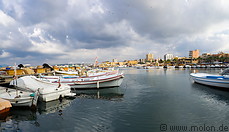
Driving a bit through Tyre, we park the car in a side street behind the harbour at 2:55pm. Then we walk to the harbour and check out a couple of restaurants. The first one looks nice and is mostly serving seafood dishes. The problem are the prices - probably you pay extra for the nice location overlooking the picturesque harbour.
Adjacent to it there is a more simple restaurant (Tony), also this serving mostly seafood and a bit cheaper. But the offering is quite limited and not what we'd like to eat.
So we walk away from the harbour towards the old town, to a restaurant shown in Google Maps. When we arrive - what a surprise - the restaurant doesn't exist. Probabl
 y it
existed once, but was closed some time ago. So we continue walking
around a bit in the old town.
y it
existed once, but was closed some time ago. So we continue walking
around a bit in the old town.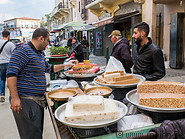
This is actually somehow picturesque. There is a souq with shops selling a multitude of things. We stop in front of a small kebab eatery and order a chicken wrap and a drink. Then we continue exploring the old town and around 4:30pm start driving back to Beirut.
When driving by Sidon I realise that the coastal highway actually breaks up in Sidon, i.e. before Sidon it ends, and after Sidon it starts again.
Once in Beirut, we drive to the ABC mall in the Verdun area of Beirut (one of the high end areas). We actually are in Beirut at 6:10pm, then it takes about 10 minutes until we have parked the car in the shopping mall and are actually in the mall (parking for two hours costs 3000 LBP).
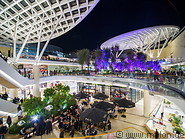 According
to its website, the ABC Verdun mall opened in 2017, i.e. is brand new.
The interior is very stylish and there are plenty of high end shops. In
the centre the roof is open, i.e. the mall interior apparently is
neither air-conditioned nor heated. Everything is nicely decorated.
According
to its website, the ABC Verdun mall opened in 2017, i.e. is brand new.
The interior is very stylish and there are plenty of high end shops. In
the centre the roof is open, i.e. the mall interior apparently is
neither air-conditioned nor heated. Everything is nicely decorated.There are restaurants on the third and fourth floors. On the third floor there is sort of a garden with trees illuminated at night. On the fifth floor there is a large cinema. There is no food court and there is no supermarket.
We have a nice dinner in one of the restaurants on the fourth floor, then at 8pm leave the mall and drive back to the hotel.
31.12: Beirut -> Anjar -> Beirut
Hotel West House residence, Beirut.
Weather: in the morning in Beirut it's a mix of overcast and sunny, with patches of blue sky (no rain). Later in Anjar the sky is again a mix of sunny and overcast, with clouds crossing the sky, but no rain. A bit fresh in Anjar, probably because of the altitude (880m). When we are back in the evening in Beirut at 7pm we see that it has been raining. Later in the evening there will be more rain in Beirut.
In the morning, since the weather looks promising, I decide to make the trip to Anjar. Anjar is at altitude in the Bekaa valley, an open air site for which I need good weather.
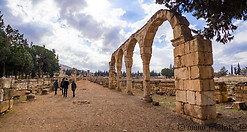 Doing Anjar when it rains is not an
option.
Doing Anjar when it rains is not an
option. We leave the hotel quite late after 10:40am. Today the streets of Beirut are really empty, not sure what happened to everybody.
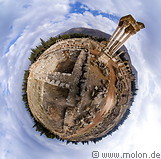 Perhaps all Beirutis went to some place outside Beirut to
party and celebrate the new year.
Perhaps all Beirutis went to some place outside Beirut to
party and celebrate the new year.The trip to Anjar proceeds smoothly. In Chtoura we stop at the Wooden Bakery shop to buy some cookies and some food in the adjacent supermarket. Then we continue driving and reach the archaeological site (the Anjar citadel) at 12:30pm. We park outside the compound and go in (ticket: 6000 LBP/adult).
The citadel dates back to the 8th century and was built under the Umayyads.
 It's a 374m x 308m rectangle. Inside the
compound there are ruins of buildings and some columns here and there
which look like Roman/Greek era columns. The largest ruin is far
behind, part of the facade of a building with some pillars and arches
behind.
It's a 374m x 308m rectangle. Inside the
compound there are ruins of buildings and some columns here and there
which look like Roman/Greek era columns. The largest ruin is far
behind, part of the facade of a building with some pillars and arches
behind. 
This is a site which doesn't look terribly impressive, but is quite photogenic, because in the photos it looks much better.
Today we are not the only non-Lebanese tourists. There are also some tour groups which arrive (luckily when we have already finished visiting the site). It's nice having an archaeological site all for yourself.
After one hour at the site,
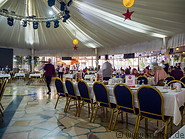 at 1:30pm we get into the car and drive to the
Armenian church. This is a relatively new church, but nevertheless
quite picturesque.
at 1:30pm we get into the car and drive to the
Armenian church. This is a relatively new church, but nevertheless
quite picturesque. After that, we get back into the car and look for a restaurant. We immediately find the Al-Shams restaurant (at 2pm). This is a huge restaurant, which is full of people, so probably is not bad. The dining hall has a circular shape with sort of a stage in the middle, where a band can play the music and people can dance.
After some discussion we are finally seated on a table far away from smoking people. Here in Lebanon lots of people smoke.Then we order some meals, which come quite plentiful. Since I'm not that hungry, I just order a simple salad for 6000 LBP and a fresh orange juice. Shirley instead is more ambitious and orders some real dishes for the kids and herself. In the end the table ends up being covered with lots of food, more food than we actually can finish.
The bill is 99000 LBP. When we check the breakdown we discover that they charged us 18000 LBP for two small dishes of plain rice (i.e. 9000 LBP for each). Misunderstanding, because the guy told us that each rice dish was 900 LBP.
 Still, they
insist that we must pay the 18000 LBP for these two plain rice dishes.
Still, they
insist that we must pay the 18000 LBP for these two plain rice dishes.Around 3:30pm we leave the restaurant. Since the Ksara winery is nearby (about 20 minutes by car), I decide to drive there to have a look.
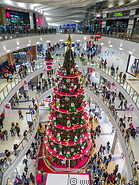 We
reach the Ksara winery at 4:05pm. Turns out that this is just the place
where you can buy or drink the wine, not actually where the wine is
produced, as was the case with the Kefraya winery. So we just spend a
few minutes here and then drive back towards Beirut.
We
reach the Ksara winery at 4:05pm. Turns out that this is just the place
where you can buy or drink the wine, not actually where the wine is
produced, as was the case with the Kefraya winery. So we just spend a
few minutes here and then drive back towards Beirut.On the way back we stop in a supermarket for some groceries, then drive to the Beirut City Centre mall. We park the car in the garage of the mall at 5:20pm.
Actually we don't do much in this mall. We walk around a bit, check some shops, then go to the Carrefour supermarket where we buy some food. Then we drive to the hotel, arriving there at 7pm.
In the evening I walk to the ATM, withdraw cash and pay the hotel room.
1.1: Beirut -> Tripoli -> Batroun
Sawary beach hotel, Batroun. Four star hotel in Batroun, a small town along the coast. A room for one person costs the equivalent of 72 USD/night (1 USD = 1500 LBP). The rooms are nice and fresh, stone floor, balcony with sea view. Fast free internet, flat screen TV, fridge, A/C unit which doubles as a heater (you need one in winter), table + chair, big mirror, leather sofa. Attached toilet with shower. What is missing is a water boiling unit (the cheap one we buy in Tripoli for 15000 LBP turns out to be completely rusty and unusable). Then there is a lack of AC power plugs in the room (there are few of them). But at least there is no noise from cars on the street and the air is much better than in Beirut.
Weather: it's raining in the morning when we leave Beirut. By the time we arrive in Batroun it's getting better and the sun is coming out. Then in Tripoli we find good weather initially (even some sun), but around 3pm it starts raining again. Very heavy rain on the coastal highway around 4:30pm, then dry again & clear sky around 5pm and again some rain after 6:30pm. Quite fresh, even cold the whole day.
We leave the hotel after 10:45am and start driving towards Batroun.
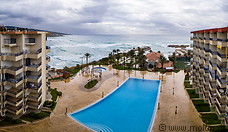 This morning the
streets of Beirut are almost empty. Probably most Beirutis are out of
Beirut and the few ones who still are in town are still sleeping.
This morning the
streets of Beirut are almost empty. Probably most Beirutis are out of
Beirut and the few ones who still are in town are still sleeping.  In
any case, we pass through streets where in th eprevious days there were traffic jams like a breeze and quickly
reach the coastal highway.
In
any case, we pass through streets where in th eprevious days there were traffic jams like a breeze and quickly
reach the coastal highway.Around 12pm we reach the Sawary hotel, check in and unload our bags in the room.
At 12:25pm we start driving towards Tripoli. Tripoli is a coastal city in northern Lebanon which is supposed to have lots of interesting Mamluk era Islamic architecture.
 Getting there takes less than 25 minutes
today.That is, we reach Tripoli before 12:50pm, but then it takes over
10 minutes to park the car near the Citadel. When we drive around the
Citadel we see that around it there are several armored personal
carriers with machine guns. Also elsewhere in the city there are
soldiers armed with machine guns. Looks like this city is a
place
which can erupt at any time.
Getting there takes less than 25 minutes
today.That is, we reach Tripoli before 12:50pm, but then it takes over
10 minutes to park the car near the Citadel. When we drive around the
Citadel we see that around it there are several armored personal
carriers with machine guns. Also elsewhere in the city there are
soldiers armed with machine guns. Looks like this city is a
place
which can erupt at any time. Perhaps the Citadel is guarded by the army because from here you can shoot all over the city if you wanted to do so. Difficult to dislodge somebody who made it into the Citadel.

The other thing that becomes apparent very quickly is how dirty and run down Tripoli is. There is rubbish and dirt everywhere on the streets. Big, run down housing blocks everywhere. Tripoli looks like a city where poor people live.
We park the car in a blind alley running parallel to the river, below the fortress. Mud, dirt, rubbish everywhere on this street. It's almost a bit embarassing to bring my ladies in such a dirty and squallid place. And to top it all, what if the stupid fortress is closed for tourists for some reason? I didn't check the security situation with anybody before driving here.
So, we walk along the dirty street, Alissia wearing her nice white and pink shoes. At the corner we turn left. Then I spot a passage with a staircase between the housing blocks.
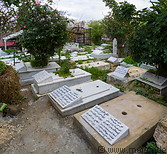 Almost looks like a waste water
channel. Seems this one is leading up to the Citadel. Probably better
to take this one, than to walk along the road.
Almost looks like a waste water
channel. Seems this one is leading up to the Citadel. Probably better
to take this one, than to walk along the road. It takes some effort to convince the ladies to take this passage. We walk up, and meet some strange people along the way. One old man saying something loud in Arabic, perhaps a prayer, then a middle-aged lady with a headscarf, who only looks at us without saying anything and probably wonders what these tourists are doing here.
Anyway, on top the path goes through an Islamic cemetery, and for the last few meters you have to walk over the tombs. But luckily at the other end it's not closed and we are in front of the fortress.

Then we walk in, and the fortress is open. Could have been locked for some reason, but it's open. There is a ticket counter but right now it's not staffed, so we just walk into the Citadel.
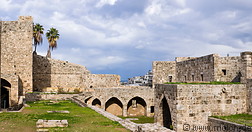 The Citadel actually is reasonably
well preserved. You can walk to the various corners, into rooms on
various levels. It's even possible to walk on top of the walls, and
from there, there is a great view of the entire city of Tripoli.
The Citadel actually is reasonably
well preserved. You can walk to the various corners, into rooms on
various levels. It's even possible to walk on top of the walls, and
from there, there is a great view of the entire city of Tripoli.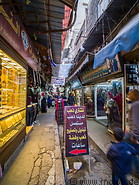 Around
1:50pm we walk out of the Citadel and go towards the souq area. There should
be more historic buildings there. We quickly are in the souq. Narrow
alleys, small shops, people with an Islamic look. 90% of the
inhabitants of Tripoli are Sunni muslims. I'm looking for the
caravanserai, but cannot find it right now.
Around
1:50pm we walk out of the Citadel and go towards the souq area. There should
be more historic buildings there. We quickly are in the souq. Narrow
alleys, small shops, people with an Islamic look. 90% of the
inhabitants of Tripoli are Sunni muslims. I'm looking for the
caravanserai, but cannot find it right now. We continue walking along the streets.
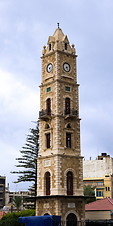 In the meantime it starts raining a bit. In
a shop Shirley buys a small water boiler. Initial price is 20000 LBP,
then we pay 15000 LBP. In reality this piece of rubbish is not even
worth 100 LBP. As we find out later, it's rusty and the electric cable
is so thin that it
gets warm when the unit is in operation. Poor quality, defective
product made in Turkey.
In the meantime it starts raining a bit. In
a shop Shirley buys a small water boiler. Initial price is 20000 LBP,
then we pay 15000 LBP. In reality this piece of rubbish is not even
worth 100 LBP. As we find out later, it's rusty and the electric cable
is so thin that it
gets warm when the unit is in operation. Poor quality, defective
product made in Turkey.At 2:28pm we are on the square with the clock tower. On the square there is a guy selling bottles (should be 33cl) of freshly squeezed orange juice for 1000 LBP (= 55 cents of a Euro) per bottle. Unbelievably cheap. We buy five bottles and Shirley even thinks whether to buy ten.
On the square we see sort of a cafe, so we stop
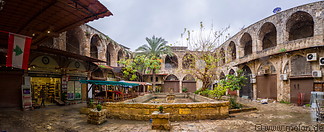 there for some food. Some people smoking the water pipe
sitting at the tables. Turns out this is a café, only drinks and snacks
are served. So we order some pancakes and crepes.
there for some food. Some people smoking the water pipe
sitting at the tables. Turns out this is a café, only drinks and snacks
are served. So we order some pancakes and crepes.We spend about one hour in this place. In the meantime the rain has become stronger.
At 3:30pm we finally continue walking. We slowly walk to the large mosque, then discover by coincidence the caravanserai and more Mamluk era architecture.
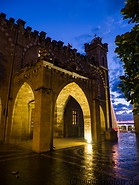 Tripoli is a gem of a city with a very rich
cultural heritage. But they should clean the streets, the city and
restore the old buildings. Because there is really so much to see here
in Tripoli and the city could get a lot more tourists if only it were
better prepared to handle tourists and cleaner.
Tripoli is a gem of a city with a very rich
cultural heritage. But they should clean the streets, the city and
restore the old buildings. Because there is really so much to see here
in Tripoli and the city could get a lot more tourists if only it were
better prepared to handle tourists and cleaner. It must be
around 4:30pm when we finally leave Tripoli and start driving back to
Batroun. On the motorway it starts raining very heavily.
It must be
around 4:30pm when we finally leave Tripoli and start driving back to
Batroun. On the motorway it starts raining very heavily.We reach the old city of Batroun around 5pm and park in a parking behind the St Stephen cathedral. I take some photos of the cathedral and the harbour, which at this time of the day (the blue hour) look very nice.
At 5:45pm we start looking for a restaurant. We end up having dinner at the Beit Merchak restaurant. Lots of people in the restaurant, but the food is a bit unimpressive (no taste). After 7pm we drive back to the hotel.
2.1: Batroun -> Qadisha valley -> Cedars of God forest -> Batroun
Sawary beach hotel, Batroun. The shower of the hotel is very bad. It alternates between freezing cold and boiling hot. We tell the reception in the morning about the problem, but in the evening when we are back the problem is still there. And BTW, they forgot to clean the room.
Weather: overcast in the morning in Batroun, but no rain. The sky opens up a bit. In Bcharré a mix of sunny and overcast, a bit cold due to the altitude (1377m). At the cedars of god forest (1989m of altitude) very cold, overcast, fog and snow. In the evening in Batroun mid temperatures, no rain.
Because the weather is not good we leave the hotel late. Around 10:45am we start driving towards the cedars of god, a UNESCO world heritage site ("Ouadi Qadisha (the Holy Valley) and the Forest of the Cedars of God (Horsh Arz el-Rab) "). I have no idea what we are going to find, but from Batroun it's only a 1:20 hours drive, so I'd like to have a look.
Initially we refuel the car, then buy some drinks. Since it's likely that we'll have lunch late, I buy some food in a bakery along the way.
Today there is more traffic on the streets. We drive for about 10km on the motorway, then get out and start driving inland. To my surprise we drive across a larger city with shops and restaurants
 (I thought in this part of the
country there would be only small villages).
(I thought in this part of the
country there would be only small villages). Then, after a few photo stops, at 12:25pm we are in sight of Bcharré, the city from which you can access both the Qadisha valley and the Cedars of God forest. Bcharré lies at an altitude of almost 1400m.
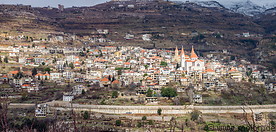 Google Maps will
now guide us to a strange place in the middle of nowhere, where there
is nothing. So I stop using Google Maps, drive back to the tourist
information centre in Bcharré and check there. We're lucky because the
tourist information centre is open today and even staffed.
Google Maps will
now guide us to a strange place in the middle of nowhere, where there
is nothing. So I stop using Google Maps, drive back to the tourist
information centre in Bcharré and check there. We're lucky because the
tourist information centre is open today and even staffed.They explain that the forest is one place and the Qadisha valley is another one. For the Qadisha valley you have to drive down a small street, park the car at the bottom and continue on foot. Lots of monasteries and chapels in the valley. In fact the entire area around Bcharré is Christian. In Bcharré itself there are two big Christian churches not far from each other.
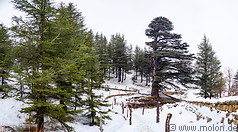
So now we drive first to the Cedars of God. The road climbs up the mountain and the higher we get the more snow there is. Finally, at 1:20pm we are on top near the forest. But there is no parking, just a narrow road and snow everywhere. The snow by the way is wet, because it is melting. We reverse and park the car a bit further up where the road is not so narrow. The altitude is 1989m.
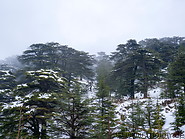
Since none of the ladies wants to get out of the car (it's cold outside), I just walk down to the forest. Everything is wet and slippery. Down next to the souvenir shops there is a staircase which leads to a path into the forest. I guess the best time to visit this place is in the middle of the summer when all snow is gone.
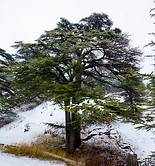
Anyway, there are many old majestic cedar trees here. Very nice trees, a pity they are not more widespread in Lebanon. There are some reforestation efforts ongoing, but it will be at least 100 years until there will be new big trees.
Today it's cold, very foggy and cloudy. I stay at the cedar forest until 1:45pm, then walk back to the car. We then drive back to Bcharré and from there drive into the Qadisha valley. The idea would be to have lunch in a restaurant in the Qadisha valley (Google Maps indicates one).
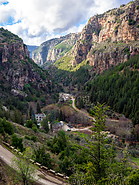
From the main road (Bcharré to the coast) we take a side road leading down into the Qadisha valley. Very narrow valley, steep cliffs, steep and narrow road, many curves. It seems that this road leads to some monasteries or churches in the Qadisha valley, but doesn't continue further towards the sea. I see a two small waterfalls, where water pours down from the cliffs and a monastery on the other side (must be the Mar Licha or Lishaa monastery).
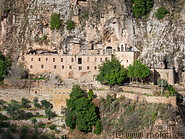 It's only a distance of
4km until the bottom of the valley, which we reach at 2:30pm. The restaurant
is closed and there is not much to see or do. We could drive up to the
Mar Lishaa monastery or continue driving on the non-paved road to the
next monastery. Since it's a bit late we decide to get back to Bcharré
and have lunch there.
It's only a distance of
4km until the bottom of the valley, which we reach at 2:30pm. The restaurant
is closed and there is not much to see or do. We could drive up to the
Mar Lishaa monastery or continue driving on the non-paved road to the
next monastery. Since it's a bit late we decide to get back to Bcharré
and have lunch there.First we stop at the Eddy's restaurant, but due to the very loud music and limited food choice we drive to another restaurant, the Sabbagh. This is a large restaurant, which however at this time of the day (3:15pm) is empty. We are the only customers.
With some effort (waiter speaks very little English) we order some food, After 4pm we drive back to the hotel in Batroun.
3.1: Batroun
Sawary beach hotel, Batroun. Also in the other room the shower doesn't work. I tell them in the morning about this, they again proimise to do something, but in the evening the problem still exists. And when we are back in the evening, again the room is not cleaned. This hotel is really bad.
Weather: quite bad weather today. In the morning it rains for hours. It's still raining when we leave tbe hotel at 12:30pm and it will only stop after 2:30pm. Then there are a couple of hours of mixed sunny/overcast weather, but at least it doesn't rain anymore.
Because it rains quite heavily in the morning and it's cold, we stay in the hotel until 12:30pm. Then we get out and drive to the Pizza Napoli restaurant. We also check the Crepaway restaurant, but discard it because it is quite pricey.
In the Pizza Napoli restaurant we order some pizzas. What they deliver are the worst pizzas I've got in quite a long time. Soft and wet like a pudding, full of greasy and oily stuff. On my chicken pizza they even add lots of barbecue sauce.
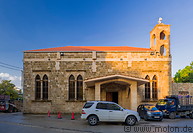 After this place I briefly
go to the Dunkin Donut shop and buy a chocolate croissant to at least
get some food. Then we
start exploring Batroun.
After this place I briefly
go to the Dunkin Donut shop and buy a chocolate croissant to at least
get some food. Then we
start exploring Batroun.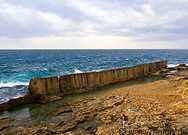 We park the car at the
Lebanese-Australian house next to the Saydet Al Seha church. We have a
quick look at this church, then walk towards the Phoenician wall.
We park the car at the
Lebanese-Australian house next to the Saydet Al Seha church. We have a
quick look at this church, then walk towards the Phoenician wall. On the way we spot the Our Lady of the Sea orthodox church. This is overlooking the Phoenician wall and is very nice, both from the outside and the inside. We spend some time in this church, then walk down to the Phoenician wall.
Between the wall and the houses
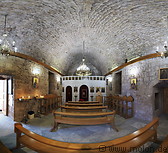 there is
a rocks area, which perhaps gets flooded at high tide. The
kids
spend some time there, then we continue walking along the coast until
we reach the harbour. This is overlooked by the St Stephen cathedral.
there is
a rocks area, which perhaps gets flooded at high tide. The
kids
spend some time there, then we continue walking along the coast until
we reach the harbour. This is overlooked by the St Stephen cathedral.While there we spot a pink pelican. Quite an unsual sight -
 we have never
seen one roaming around free (only in the zoo). We get closer to take
some pictures, until we are just 2m from the bird. This pelican is not
afraid of us, and is actually more busy trying to snatch a fish from a
fishing net.
we have never
seen one roaming around free (only in the zoo). We get closer to take
some pictures, until we are just 2m from the bird. This pelican is not
afraid of us, and is actually more busy trying to snatch a fish from a
fishing net.Then we walk to the St George Greek Orthodox church, which however today is closed. I then drop my ladies in the Seaside road and while they buy some food in a supermarket, I walk back to the car.
When I'm back and pick them up, they tell me they bought a Kinder chocolate egg in the shop. When they opened it, it was full of fungus inside. But the shop owner lady refused to return the money.
We then drive to a Greek orthodox church some km north of Batroun, which I have spotted in the Google Maps. It's the Our Lady of Noorieh monastery.

While driving I notice that north of Batroun, along the coast there is an industrial area. Which is interesting, because it shows that Lebanon has some own industry (manufacturing or processing something). It's not just a services and tourism economy.
I first drive along the coastal road, to have a look at the coast.
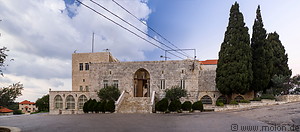 It's a
rocky coast, with steep cliffs, no sandy beaches. At one point I'm on
the road right below the monastery. Turns out that the monastery is on
a hill overlooking the sea. From here it's another 8km along a narrow
road to reach the monastery.
It's a
rocky coast, with steep cliffs, no sandy beaches. At one point I'm on
the road right below the monastery. Turns out that the monastery is on
a hill overlooking the sea. From here it's another 8km along a narrow
road to reach the monastery.It's 4:34pm whenwe finally we are at the monastery. This seems to be a not so old monastery, judging from the architecture. There is a chapel on an inner court. Some people arriving, prayers or some other service ongoing in the chapel. Nice views of the bay from the viewpoint.
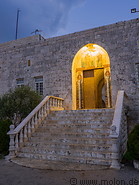
At 5pm, when we are about to leave, a cat shows up. A young cat, quite cute. The kids are immediately very interested and this cat is well-mannered and not afraid of people. 15-20 minutes of cat patting and playing follow. Cat going into the car, girls insisting that we bring the cat with us to the hotel. Make it sleep in out bed.
It takes a while to get rid of this cat, and then we drive back to Batroun.
In Batroun we spend some time looking for a restaurant, but can't find a suitable one. The two ones we tried out are not good and lots of places are closed, probably because of the winter season. Then there are some take away places, which however do not serve the food we are looking for. In the end we buy some bananas in a shop, some drinks, some pastries in a bakery and a chicken burger. We'll have that in the hotel, rather than wasting money on bad food in a restaurant.
4.1: Batroun -> Beirut
Silver apartments, Beirut. The equivalent of 54 USD/night for a small apartment with a kitchen/living room, bathroom with shower, a bedroom and a corridor. I book two rooms, and one has a smelly toilet. Heating via an A/C unit which doubles as a heater. The kitchen/living room has an LCD TV, gas stove, refrigerator, sofa, chairs, small table, cooking equipment. WLAN exists, but they want 10 USD/day for it. The apartment is on a busy road (ear plugs needed for sleeping).
Weather: overcast and rain the whole day. It rains less after 5pm.

In the morning we pack our bags and leave the Sawary hotel at 11:30am. Again the shower hasn't worked properly. We drive to the Kaddoum restaurant in Byblos, because there the food is good.
If today had been a sunny day, I would have spent some time in Byblos, then driven to the Our Lady of Lebanon shrine above Jounieh and then to the hotel in Beirut. But with such a bad weather, the only option is to do indoor things (basically the national museum in Beirut and perhaps a shopping mall).
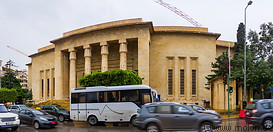
We have a lunch in the Kaddoum restaurant between 11:50am and 12:40pm, then drive to Beirut. Again there is a lot of traffic in the coastal highway, and as a consequence we need over 1:20 hours to reach the national museum in Beirut. By the way, lots of water on the motorway (car every now and then driving through puddles of water).
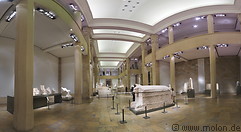 Around 2:15pm we reach the national museum and park
the car in a parking near it (2500 LBP for the first three hours). Next
to this museum is some kind of agency or ministry of security - a
building heavily guarded by armed people.
Around 2:15pm we reach the national museum and park
the car in a parking near it (2500 LBP for the first three hours). Next
to this museum is some kind of agency or ministry of security - a
building heavily guarded by armed people. 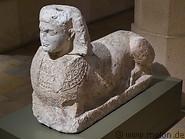 The museum is
smaller than I thought. It's inside a building and extends over three
floors (basement, ground floor and first floor). Cameras allowed, but
no flash. It's much smaller than I would have imagined. It contains a
collection of artifacts from prehistoric ages until the Islamic period.
The most interesting exhibits are in the basement (some mummies and
examples of the Phoenician script).
The museum is
smaller than I thought. It's inside a building and extends over three
floors (basement, ground floor and first floor). Cameras allowed, but
no flash. It's much smaller than I would have imagined. It contains a
collection of artifacts from prehistoric ages until the Islamic period.
The most interesting exhibits are in the basement (some mummies and
examples of the Phoenician script).The ticket costs 5000 LBP for adults and 1000 LBP for students.
At 4:20pm we leave the museum and walk back to the car, then drive to the hotel. Heavy traffic on the streets. We park the car in front of the hotel and check in. In the evening, at 7pm we have a dinner in the BBQ house restaurant opposite the hotel (good food, competitively priced for Lebanon).
5.1: Beirut
Silver apartments, Beirut. The shower has a limited amount of hot water. Enough for one person, but if more than one person needs to take a shower, you have to wait until there is hot water again.
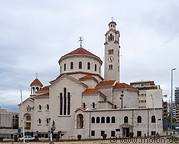 Weather:
overcast the whole day, around noon some sunshine. It rains a few times
over the entire day, every time 20-30 minutes. It's possible to walk
around with an umbrella without getting too wet, or you could stop
somewhere in a dry place and wait for the rain to finish.
Weather:
overcast the whole day, around noon some sunshine. It rains a few times
over the entire day, every time 20-30 minutes. It's possible to walk
around with an umbrella without getting too wet, or you could stop
somewhere in a dry place and wait for the rain to finish.We sleep long until 10:30am, then leave the hotel after 12pm. I initially key in the American University, but then stop along the way at the St Gregory Armenian catholic cathedral.
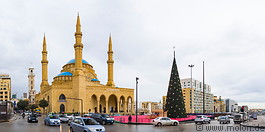
From there we walk to the Al Amin mosque, which today is open for visitors. Anybody may get in. You have to take off your shoes and women have to be dressed modestly and cover their hair. Inside the mosque has a huge prayer hall with a beautifully decorated ceiling. Despite being Friday, the hall is almost empty.
It's 1:10pm when we get out of the mosque.
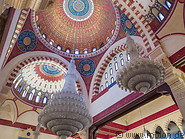 I walk with my
mom to the nearby Dunkin Donuts outlet when Shirley and the kids have
been waiting for us (they didn't want to go into the mosque). There we
have a snack, then continue walking. First we pass by the Mansour Assaf
mosque (closed today), then we reach the Al Omari mosque. This one is
open today, so we walk in.
I walk with my
mom to the nearby Dunkin Donuts outlet when Shirley and the kids have
been waiting for us (they didn't want to go into the mosque). There we
have a snack, then continue walking. First we pass by the Mansour Assaf
mosque (closed today), then we reach the Al Omari mosque. This one is
open today, so we walk in.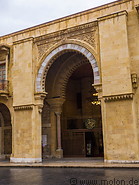
The Al Omari mosque is much smaller than the Al Amin mosque. Inside it looks like a Christian church which has been converted to a mosque. Actually I also see some pillars which look as if they were from the anicent Rome age.
Shortly before 2pm we walk out. The ladies will wait for me on the Waygand street, while I walk back to the car and pick them up again. When I stop with the car in the Waygand street to pick them up an angry policeman threatens to take my licence plate number and fine me.
I key in the American University into Google Maps and we drive there. At first Google Maps directs me to a place along the Corniche, but that's the wrong entrance. Some discussion with the guard and he tells me that the entrance for visitors actually is in Bliss street.
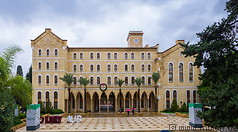
We could walk there, but it takes 15 minutes and it might rain. So we get back to the car and drive to Bliss street. We leave the car in a parking in Makhoul street (3000 LBP fee), then walk to the main building. Lots of shops selling stationery equipment and some cafes and restaurants in the area, but none selling particularly good food.
The American University of Beirut was founded in 1866 by Daniel Bliss. On the compound there are several buildings in 19th century architecture. Visitors can get into the compound, but may not enter into the buildings.
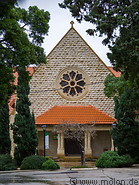 There is also a certain number of cats,
and my girls are immediately interested and start playing with them.
Shirley buys then some cat food in the pet food shop opposite the
university. The cats freak out and start fighting for the food. You can
see the rank and who is the alpha cat.
There is also a certain number of cats,
and my girls are immediately interested and start playing with them.
Shirley buys then some cat food in the pet food shop opposite the
university. The cats freak out and start fighting for the food. You can
see the rank and who is the alpha cat.At 3:10pm we finally leave the university compound. Since it's raining and cold and we haven't had lunch, the idea would be to stop in a cafe for a snack, then drive back to the hotel. We walk around a bit, but find no place where we could have something small. All portions are full meal size.
 So,
after some time, we just get back to the car. I key in the Beirut mall,
because it's on the way back and should have some cafes or places where
we can have a snack. It's 3:55pm and we should be at the mall in half
an hour. Then we get stuck in traffic jams, because we have to drive
through Beirut and at this time of the day there are always traffic
jams in Beirut. Too many cars, not well-mannered drivers.
So,
after some time, we just get back to the car. I key in the Beirut mall,
because it's on the way back and should have some cafes or places where
we can have a snack. It's 3:55pm and we should be at the mall in half
an hour. Then we get stuck in traffic jams, because we have to drive
through Beirut and at this time of the day there are always traffic
jams in Beirut. Too many cars, not well-mannered drivers.We'll be at the Beirut mall shortly before 5pm. This Beirut mall is not so big (actually quite small for a mall) and has seen better days. For some reason half of the shops are closed. There is a gaming centre on the highest levels and just one not so great cafe in the ground floor.
We don't spend much time in this place and get out within 10 minutes. Next to the mall there is a bakery/pastry shop, actually even a good one. Lots of stuff, own production, good quality. So we buy some food there and then drive to the hotel.
In the evening we have a dinner again at the BBQ house place.
6.1: Beirut -> Rome -> Munich
Home, sweet home.
Weather: dry, but fresh in Beirut. In Rome it's a beautiful sunny day, temperatures around 7°C in the early morning. Sunny & blue sky and 6°C in Munich when we land.
 We leave the apartment at 2:10am. The apartment caretaker is
surprisingly there to say good bye to us (or perhaps to make sure that
we leave the keys there).
We leave the apartment at 2:10am. The apartment caretaker is
surprisingly there to say good bye to us (or perhaps to make sure that
we leave the keys there).
We are at the airport before 2:30am. Then we spend 40 minutes in a security screening queue, where basically you have to screen all your baggages. That is even before you can go to the check-in counters.
At 3:05am we are finally through and proceed to the check-in counters. Luckily there is no queue and they quickly give us the boarding passes. Then we start walking towards the gate.
First we have to go through passport control. Then, there is another security check before we are allowed to reach the gates. We keep walking, walking all the time. It's almost 4am when we finally reach the gate and boarding has already started.

When we get into the plane I notice that all overhead compartments are taken by large baggages. But luckily those above our seats are still not full.
While we are still on the ground, one of the pillows drops from a seat to the aisle. The Alitalia hostess passes by and instead of picking up the pillow and asking whose pillow it is, kicks the pillow to the side with her foot.

The plane takes off at 4:33am, with a small 8 minutes delay. On board they serve a sandwich (cheese or turkey) and a drink. I manage to sleep a bit.
We land in Rome Fiumicino airport at 6:45am local time, a bit ahead of time (scheduled arrival is 7am). There is a bus to pick
 us up and bring us to the terminal. From
there we walk through a series of checks (initial security screening,
then passport control). It takes a very long time to reach the
departure gate. The airport is new, but the layout is not optimal. Too
much walking to reach the gates.
us up and bring us to the terminal. From
there we walk through a series of checks (initial security screening,
then passport control). It takes a very long time to reach the
departure gate. The airport is new, but the layout is not optimal. Too
much walking to reach the gates.Shortly after 9am we get on the plane. This starts rolling at 9:23am and takes off at 9:33am, with just 8 minutes of delay. The plane is an A319 and is not completely full (several empty seats).
We touch down in Munich at 10:41am and reach the terminal at 10:45am, 15 minutes ahead of time. Then it takes a while to retrieve the luggage (until 11:20am). Shortly after 12pm we take the train back home.
Copyright
2018 Alfred
Molon